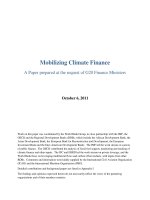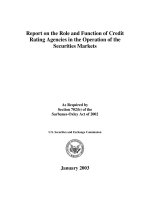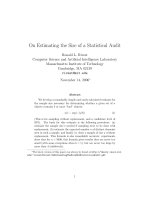The.1-2-3.Money.Plan.Oct.2010_5 potx
Bạn đang xem bản rút gọn của tài liệu. Xem và tải ngay bản đầy đủ của tài liệu tại đây (345.87 KB, 21 trang )
ptg
66
The 1-2-3 Money Plan
environmental reasons and because they con-
sider it to be more healthful.
Organic produce typically costs 25 percent to
100 percent more than nonorganic. Especially
in challenging economic times, that has con-
sumers reexamining their choices. Here are
some do’s and don’ts when trying to save
money on organic food:
● Don’t settle for “natural.” The term natural
on packaging has a lot less meaning than
organic, a term highly regulated by the
Department of Agriculture. Don’t pay extra
for something called natural or all natural.
● Do pay for some fruits and vegetables. It’s
worth paying more for organic versions of
some fruits and vegetables that retain pesti-
cide residue, even after you wash them. Pay
for organic versions of peaches, apples,
sweet bell peppers, celery, nectarines,
strawberries, cherries, pears, grapes,
spinach, lettuce, and potatoes, according
to the Environmental Working Group, a
nonprofit organic research group.
● Don’t pay more for fruits and vegetables
with thicker skins that have far less pesti-
cide residue. You can skip organic onions,
avocados, sweet corn, pineapples, mango,
asparagus, sweet peas, kiwi, bananas, cab-
bage, broccoli, and papaya.
From the Library of Wow! eBook
ptg
67
Get FIT (Food, Insurance, Telecommunications)
● Do buy organic protein-rich foods. Meats,
poultry, eggs, and dairy products are worth
buying as organics because they are free of
pesticides, synthetic growth hormones, and
antibiotics.
● Don’t buy highly processed organics.
Breads, oils, potato chips, pasta, cereals,
and other packaged foods, such as canned
or dried fruit and vegetables, are probably
not worth buying as organics unless price is
no object, Consumer Reports said. Much of
the health benefit has been processed out.
● Do buy organic baby food. Baby food tends
to be made from condensed fruits and veg-
etables, some of which might contain pesti-
cides. Or make your own baby food from
organic whole fruits and vegetables.
● Do buy local. You can find organic food
from local farmers’ markets and local
producers.
● Do try store brands. More supermarkets
and large discounters, such as Wal-Mart,
are offering private-label organics, which
are cheaper than name brands.
● Do use coupons. Look for coupons for
organic products in the Sunday newspaper
or go online to the free coupon database at
CouponMom.com and enter the search
term “organic.” Get coupons directly from
From the Library of Wow! eBook
ptg
2. Stockpile Sale Items
This gets to the heart of the spending smart strategy on
groceries: Each week, don’t buy what you need. Instead,
buy what’s on sale, and stock up.
This cherry-picking strategy sounds simple enough,
but it has a few moving parts.
• Loyalty cards. In most supermarkets, you’ll have
to sign up for a store loyalty card to qualify for
sale prices. Supermarkets nowadays don’t typi-
cally have sales that apply to everyone. Make no
mistake: The supermarket is tracking your pur-
chasing habits. That might give you the willies.
But in the end, it’s doubtful that anyone will ever
examine what you were buying. And who cares?
68
The 1-2-3 Money Plan
organic producers’ Web sites and sign up
for their e-mail newsletters, which contain
coupons. Examples are OrganicValley.com,
SCOjuice.com, ColemanNatural.com, and
Stonyfield.com. The site Healthesavers.com
has printable coupons for some organic
products.
● Do grow your own. If you are the garden-
ing type and have a back yard, grow your
own vegetables and receive the side benefits
of exercise and a regular hobby.
For more information, see GreenerChoices.org,
FoodNews.org, and OrganicConsumers.org.
From the Library of Wow! eBook
ptg
Someone could follow you around the store—a
public place—and collect the same information.
Anyway, a loyalty card is often the only way to
qualify for sale prices, and shopping the sales is
your best weapon to lowering your food spending.
• Sales flyers. Examine the weekly sales flyers for
advertised specials. They often come in the news-
paper or by mail. You can also go online to
mygrocerydeals.com, which has digital versions of
many sales flyers. Pay special attention to what’s
advertised on the front and back covers. They are
likely to be loss leaders, meaning the store is sell-
ing them so cheaply they’re actually losing money.
They hope to attract buyers into the store to pur-
chase more high-profit items, which compensates
for the loss leaders. I’m not going to tell you how
to plan your meals, but if you can plan dinners
around these loss leaders, you can save big dough.
• Unit prices. Some items are sold in different-sized
packages. Unless your supermarket lists the unit
price on the shelf, you’ll have to do the math your-
self. You could bring a calculator or reach for
your cell phone. Most wireless phones have a cal-
culator function. For each item, divide the price
by the number of units, such as ounces or pounds.
That allows you to literally compare apples to
apples.
If you go to the supermarket every week with a list
of what you “need,” you’ll be paying far more than you
have to. The idea is that when you “need” something,
you should go to your own pantry or freezer and fetch
the item, which you previously bought on sale.
69
Get FIT (Food, Insurance, Telecommunications)
From the Library of Wow! eBook
ptg
How much can you save by stockpiling sale items?
Most experts put the savings at around 20 percent of
your entire food spending for a year. Considering the
average American household of four spends about
$7,000 on grocery food, housekeeping supplies, and
personal-care items, you’re talking about savings of
about $1,400 a year. And that excludes other categories
of supermarket items that go on sale, such as over-the-
counter medications.
That’s $1,400 in savings for buying the exact same
items, but buying them at ideal times.
There can be drawbacks to this strategy. Obviously,
perishables don’t stockpile well. Don’t buy more perish-
able food than you will reasonably use before it goes
bad, or your savings will be lost. Also, some people,
especially those living in urban areas, have less pantry
and freezer space to stockpile supermarket items. The
stockpiling system will only work on a smaller scale for
those people.
70
The 1-2-3 Money Plan
QUICK TIP
Try supermarket store brands. They’re so much better
than the “generics” of a generation ago. In fact, many
store brands are made by the same manufacturers that
make name-brand food products.
From the Library of Wow! eBook
ptg
71
Get FIT (Food, Insurance, Telecommunications)
Freezing Times
Freezer Storage Chart (0 °F)
Note: Freezer storage is for quality only.
Frozen foods remain safe indefinitely.
Item Months
Bacon and sausage 1 to 2
Casseroles 2 to 3
Egg whites or
egg substitutes 12
Frozen dinners and
entrees 3 to 4
Gravy, meat, or poultry 2 to 3
Ham, hot dogs, and
lunch meats 1 to 2
Meat, uncooked roasts 4 to 12
Meat, uncooked steaks
or chops 4 to 12
Meat, uncooked ground 3 to 4
Meat, cooked 2 to 3
Poultry, uncooked whole 12
Poultry, uncooked parts 9
Poultry, uncooked giblets 3 to 4
Poultry, cooked 4
Soups and stews 2 to 3
Wild game, uncooked 8 to 12
Source: USDA
For more information on freezing food, go online
to www.fsis.usda.gov/FactSheets/Focus_ On_
Freezing/index.asp
From the Library of Wow! eBook
ptg
72
The 1-2-3 Money Plan
Cherry-Picking Pays
Consumers who regularly visit multiple super-
markets and “cherry-pick” the best deals not
only save money, but also save enough to offset
the time it takes to do the extra shopping. This
is the conclusion of an academic study by
University of Pennsylvania Wharton marketing
professor Stephen J. Hoch and Edward J. Fox, a
marketing professor at the Cox School of
Business at Southern Methodist University.
How is this possible? First, these supershop-
pers’ advance preparation allows them to get
significant price reductions on a number of
items. Second, and more important, they com-
pound those savings by purchasing multiple
items when they’re cheap. Savings from visiting
a second store alone paid the equivalent of
about $16 per hour. Considering price inflation
since the study was conducted, that’s nearing
$20 per hour today.
QUICK TIP
Warehouse clubs, such as Costco, Sam’s Club, and BJ’s
Wholesale, are great for some items and not for others.
They can end up saving more than the membership fee
if you’re judicious about what you buy. For example,
paper goods are often cheaper at a warehouse club.
Your price list will advise you on what the best deals
are. Of course, you don’t want to buy perishable food
in such large quantities that you end up throwing out a
large portion that spoils.
From the Library of Wow! eBook
ptg
3. Match Coupons to Sales
You can save significant money by doing the first two
steps and skipping coupons. But you certainly will be
leaving money on the table.
For the most savings, you’ll want to match a coupon
with a sale. This is the big secret for the most strategic
of shoppers. For those shoppers, about two-thirds of
their savings comes from shopping sales. An additional
one-third comes from using coupons.
However, the key with coupons is to avoid hassle. If
you have the time and inclination to clip coupons,
neatly file them in some type of organizer and weed out
expired coupons, go for it. Many people have their own
filing systems or use such products as the Couponizer,
found at www.couponizer.com.
One low-hassle way is the CouponMom system. Get
the coupon circulars from the Sunday newspaper, write
the date on the front and put them aside, perhaps in a
closet or drawer. In preparing to go shopping, go online to
CouponMom.com. It is free, although you must register.
CouponMom has two main tools. The first is
“Grocery Deals by State,” which each week lists the
best deals at your local supermarket, noting sales and
coupons. For coupons, it will tell you the date and the
circular to clip the coupon from. That way, you can
fetch the coupon circulars from the closet or drawer and
clip coupons only as you’re going to use them.
The Web site also has a listing of all current coupons
in its “Grocery Coupon Database.” If your supermarket
isn’t listed in “Grocery Deals by State,” you can choose
sale items you want in the weekly circular and look
73
Get FIT (Food, Insurance, Telecommunications)
From the Library of Wow! eBook
ptg
them up in the database to determine whether there’s a
matching coupon.
A similar system is at TheGroceryGame.com. It has
a small fee, but has a free trial. Some users like it better,
especially because it includes unadvertised sales and
firmly advises you on what’s a good deal versus a great
deal. HotCouponWorld.com is another good site,
mostly for hard-core strategic shoppers. It has a robust
message forum where frugal denizens trade shopping
tips. It is free.
74
The 1-2-3 Money Plan
302 billion—Number of coupons offered in 2007
2.6 billion—Number of coupons redeemed in 2007
$150,000+—Household income for biggest users of
coupons
80%—Portion of coupon users who are female
Source: 2007 CMS Consumer Study
FIGURE 3.1 Coupons: by the numbers
If you’re looking for low hassle, just use Sunday
newspaper coupons. If you’re more enthusiastic, you’ll
want online printable coupons too. Besides some of the
Web sites already mentioned, get online coupons from
such sites as SmartSource.com, Coupons.com,
CoolSavings.com, and Eversave.com. There are literally
dozens of other sites you can find with an Internet
search engine, but after viewing a few, you’ll discover
they offer mostly the same coupons.
From the Library of Wow! eBook
ptg
The big-picture strategy here is to recognize a good
price on supermarket items. When you find one, you
pounce, by stockpiling and slapping a coupon on it.
75
Get FIT (Food, Insurance, Telecommunications)
QUICK TIP
Pay attention to “Catalinas.” These are checkout
coupons handed to shoppers with grocery store
receipts. The coupons, named after Catalina
Marketing—the company that pioneered their use—
often lead to savings and free items.
Fun Tangent: Razor Blades
Razor blades are among those repeat purchases
at the supermarket or drug store that can tick
off consumers more than many others. That’s
because replacement cartridges on higher-end
shavers can be so expensive.
To save money, you could buy cheaper blades,
but many consumers claim the more expensive
new razors with more blades are, indeed, supe-
rior. So, the other way to spend less is to make
blades last longer.
How? Dry your razor blades daily.
Razor blade dullness occurs more from oxida-
tion—rusting—than from contact with whiskers.
Water resting on blades between shaves causes
the rusting. So keep your razors dry. After every
From the Library of Wow! eBook
ptg
Food Away from Home
The first rule of dining out for less is to do it infre-
quently. By all means, go out to celebrate a wedding
anniversary or job promotion. But try to avoid loading
the family in the car and going to a restaurant because
you’re a poor meal planner. And when dining out, look
for reasonable ways to cut your tab without cutting
enjoyment.
76
The 1-2-3 Money Plan
use, shake it vigorously to dislodge water
droplets, blot it on a towel and even give it a
brief blow-drying if a hairdryer is nearby. It’s
also a good idea to store your razor outside the
bathroom to avoid steam and humidity from
getting to blades. Or store the dry razor in a
sealable plastic bag.
My own test involved drying a Gillette Fusion
razor after every use. I used the same cartridge
for three months, compared with the usual two
weeks. And I’ve been drying my razors ever
since.
Food Away from Home, 1-2-3
1. Make freezer meals.
2. Use coupons and discounts.
3. Skimp on what you don’t care about.
From the Library of Wow! eBook
ptg
1. Make Freezer Meals
We’ve all done it. Dinnertime sneaks up on us, we don’t
have anything planned and don’t feel like cooking. The
easiest solution is takeout, delivery, or schlepping to the
nearest chain restaurant.
The simple solution is freezer meals. It’s different
from simple leftovers in the fridge. With freezer meals,
you make double and triple batches when you cook—
hamburgers, meatloaf, casserole, whatever. Then on
those harried evenings, you’re only microwave minutes
away from a quicker, more healthful, and less-expensive
entrée than you probably would get dining out. Whip
up a few quick sides, and presto! A meal.
A little meal planning goes a long way toward saving
money—and not just on dinner. Taking lunch to work
instead of buying is, admittedly, obvious and tired
advice. But do you brown-bag it every day? Ask your-
self why not. And what about that morning latte from
Starbucks that every money advice-giver wants to cut
from your morning routine? Well, that’s up to you, of
course. Just make sure it’s truly how you want to spend
your money. You might have seen the math before, but
I’ll repeat it here: Cut a $4 coffee and $7 lunch each
workday, and you save $2,750 a year. If nearly three
grand is no big deal to you and you don’t need to spend
it on something else, then eat out.
2. Use Coupons and Discounts
Granted, if a man is on a first date, he might not want
to whip out coupons when the bill comes, unless he
77
Get FIT (Food, Insurance, Telecommunications)
From the Library of Wow! eBook
ptg
knows his date is of like-minded frugality. But coupons
and discounts can save significant money on dining out.
One secret method keeps anyone from knowing you’re
getting a discount. Sign up at RewardsNetwork.com. Tell
them what credit cards and debit cards you use to pay for
meals, and if you dine at a participating restaurant, you
get a discount automatically credited to your credit or
debit account. You do nothing—no coupons or gift certifi-
cates. Discounts are typically 5 percent to 10 percent.
Also check out Restaurant.com, OpenTable.com,
and the ubiquitous Entertainment book from
Entertainment.com. If you’re looking for a cheap way
to take the kids out, look for special deals at
KidsMealDeals.com.
3. Skimp on What You Don’t Care About
Sometimes, we’re on autopilot at a restaurant, ordering
a soft drink, appetizer, entrée, and dessert. Then we
wonder why we’re so uncomfortably full when we
leave. Cut out what you don’t care about.
Do you like free water just as well as a $3 soft drink?
Can you wait until you get home for a beer or glass of
wine? Can you skip the appetizer or eat an appetizer and
skip the entrée? Are the portions big enough to share an
entrée? What about skipping the tempting dessert and
coming back some other time for dessert only?
This isn’t rocket science, but it does take discipline
and a willingness to break your routine. Listen to your
body about how hungry you actually are and order less.
And look for reasonable substitutions that will cut your
tab without cutting your enjoyment.
78
The 1-2-3 Money Plan
From the Library of Wow! eBook
ptg
Insurance
Insurance is a wide-ranging topic, and some people have
unique insurance needs. But here are three things almost
everybody can do to save money.
79
Get FIT (Food, Insurance, Telecommunications)
Insurance, 1-2-3
1. Say no to extended warranties and other
junk insurance.
2. Refinance your term life insurance.
3. Raise deductibles on home and auto
insurance.
1. Say No to Extended Warranties and
Other Junk Insurance
Keep things simple and don’t outsmart yourself. There’s
a lot of junk insurance out there that is way too expen-
sive for the risk it covers.
Extended warranties are at the top of the list. Just
don’t buy them. How’s that for simple? Don’t buy them
on electronics, computers, cars, appliances, or anything
else. Does anybody really think a $40 extended war-
ranty on a $200 camera is a good deal?
Are there examples of extended warranties paying
off? Of course. And there are examples at a casino
roulette wheel, when the ball falls into the number 8
slot. There’s also a chance you might die from a snake
bite this year. It’s just not very likely. The point is,
almost all extended warranties are a lousy bet.
From the Library of Wow! eBook
ptg
Similarly, don’t sign up for a home warranty, or serv-
ice contract, which is essentially insurance on your
appliances and major operating systems, like a furnace.
You can skip many of these insurances if you main-
tain an emergency fund to pay for repairs. Here’s a sim-
ple concept: When stuff breaks, pay to repair it. Don’t
make it more complicated than that. You’ll save money
in the end.
Here’s an idea—self insure. Whenever you’re
tempted to buy an extended warranty, say no. Then put
the money you would have spent on the warranty into
a separate bank account. That will act as your repair
fund. Chances are that over time, you’ll put far more
into the account than you spend on repairs.
I’m not necessarily saying you should check your
brain at the door and blindly reject every offer. But
you’ll do well to make “no” your default answer and set
a high hurdle for saying “yes.”
2. Refinance Your Term Life Insurance
Term life insurance premiums have been plummeting
for years. So, if you have an old policy, it’s time to get a
new one, and then cancel the old one. In all likelihood,
you can either save a lot of money or get a lot more cov-
erage for the same money, even though you’re older
than when you first took out the policy.
I call this “refinancing” because it’s so similar to refi-
nancing your house mortgage to a better interest rate,
only replacing your life insurance is better because the
switch is free. It’s a no-brainer.
80
The 1-2-3 Money Plan
From the Library of Wow! eBook
ptg
You can save literally hundreds of dollars a year,
which compounded over the life of a 15-year or 20-year
policy amounts to thousands in savings.
What exactly is life insurance? A life insurance com-
pany pays your beneficiaries a lump sum of money if
you die while the policy is in place.
A quick rule of thumb on whether you need life
insurance: If anyone depends on your income, you need
life insurance. So, single, childless people probably
don’t need it. An example of an exception is a stay-at-
home mom. If a surviving working dad would have to
hire childcare and other services the stay-at-home mom
performed, you might want a small policy on her.
A quick rule of thumb on how much life insurance to
buy: Get 6 to 10 times your income. This is a fuzzy num-
ber, like so much in financial planning is. So buy as close
to 10 times your income as you can reasonably afford.
Or, you can go through some laborious guestimate calcu-
lators online at Bankrate.com, Moneycentral.msn.com,
Insurance.com, and AccuQuote.com. Be aware you’re
likely to get wildly different estimates.
How do you refinance your term life insurance? In
short:
• Find a better price on guaranteed “level” term,
which means coverage is guaranteed throughout
the policy’s term and the premium will not change.
• Sign up and take a physical.
• Cancel your old policy or let it lapse by not pay-
ing the premium.
• Save money.
81
Get FIT (Food, Insurance, Telecommunications)
From the Library of Wow! eBook
ptg
Be sure to get your new policy in place before cancel-
ing your old policy. That way, if the medical examina-
tion discovers some disease or condition that makes you
uninsurable, you can just keep the old policy.
Start by asking your existing life insurance company
what current premiums would be for the same coverage.
Then go online to life-insurance comparison sites, such
as AccuQuote.com, SelectQuote.com, Insure.com,
Efinancial.com and Intelliquote.com. Be aware that
some sites will give you an instant quote on life insur-
ance, while others simply pass your name on to
insurance brokers who will contact you. The sites listed
previously should give you an instant quote.
If you’re having trouble deciding on a site, use
AccuQuote.com, one of the oldest comparison sites on
the Web. It also offers help by telephone, 1-800-442-
9899. You get the same rate regardless of whether you
get a quote online or with help on the phone.
How do you know if the quote you received is from
a good insurance company? Only consider companies
rated A-plus or above. Many comparison sites list the
ratings along with the price quotes, or you could check
them out yourself at such rating sites as standardand-
poors.com, ambest.com and fitchratings.com.
82
The 1-2-3 Money Plan
From the Library of Wow! eBook
ptg
Don’t have term life insurance? Do you have whole
life, universal life, variable life, or some other cocka-
mamie cash-value life insurance policy with an invest-
ment component? You might do better to cash it in and
get regular term insurance. It will be far cheaper. Or
looked at another way, you could be getting a lot more
life insurance for the same money. The problem is that
permanent life insurance policies are so complicated,
they’re difficult to analyze. To help decide whether to
dump a cash-value policy, get an analysis of your policy
for a relatively small fee at the Consumer Federation of
America, at EvaluateLifeInsurance.org. An expert there,
James Hunt, a former insurance commissioner of
Vermont, will analyze your policy for a reasonable fee,
which at this writing was $70 or $80, depending on the
type of policy. He’ll recommend what you should do
with your policy.
Contact information: James H. Hunt, 8 Tahanto St.,
Concord, NH 03301-3835,
,
603-224-2805. Okay to call on evenings and weekends.
83
Get FIT (Food, Insurance, Telecommunications)
QUICK TIP
Don’t buy child life insurance or specific-death insur-
ance. You don’t depend on a child’s income, so don’t
buy life insurance for a kid. And if you need life insur-
ance, it doesn’t matter how you die—cancer, heart
attack, or stepping off the curb and getting hit by the
proverbial bus. So don’t buy specific-death insurance.
Just get regular term insurance.
From the Library of Wow! eBook
ptg
3. Raise Deductibles on
Home and Auto Insurance
Insurance is to protect you from financial disaster, not
minor money annoyances. That’s partly why you want
high deductibles on your home and auto insurance.
Another reason is answered with a question: What do
you think will happen if you submit an auto insurance
claim for a few hundred dollars? That’s right. You
insurer might fire you as a customer and cancel your
insurance. So, if you’re not going to make small
claims—and you shouldn’t—you might as well raise
your deductibles. A deductible is the amount you have
to pay before insurance starts paying. When you raise
deductibles, the insurance company lowers the premium
you have to pay.
Consider deductibles of $500 or even $1,000 on
auto insurance, and $1,000 to $2,500 on home insur-
ance. You’ll save 15 percent to 30 percent off your
premiums.
84
The 1-2-3 Money Plan
QUICK TIP
Insurance for home and especially auto can vary dra-
matically from insurer to insurer. It pays to periodi-
cally shop around. Yes, it’s a pain. But, yes, it’s worth
it. Today, you can get quotes online at such sites as
www.insurance.com, www.instantquote.com, or
www.insweb.com.
From the Library of Wow! eBook
ptg
Telecommunications
I’m going to lump several types of services together
under telecommunications because more and more,
that’s how consumers buy them. I’m talking about serv-
ices for your home phone, wireless phone, pay televi-
sion, and Internet access.
The big idea with telecommunications is to pay
attention. These services are evolving so quickly that
new services and new prices are offered all the time. It
pays to evaluate all your telecom services at least annu-
ally, if not quarterly. When it comes to telecom, paying
attention pays off.
85
Get FIT (Food, Insurance, Telecommunications)
Telecommunications, 1-2-3
1. Cancel your traditional landline phone
service.
2. Rightsize your wireless phone plan.
3. Regularly review TV and Internet service.
1. Cancel Your Traditional Landline
Phone Service
“No way! He did not just suggest dumping my house
phone line.”
Oh, yes, he did.
A dial tone to your home phone has become a com-
modity. That means it’s not special anymore. And it’s
definitely not worth paying $40 a month for service,
plus extra for long-distance calls. Today, unlimited, free
From the Library of Wow! eBook
ptg
long-distance calls are a throw-in feature, like call-
waiting or caller ID.
You can get phone service so many ways nowadays
that traditional landline phone service from a Ma Bell
descendent has become a dinosaur. That’s why you
should consider dumping your traditional stand-alone
landline altogether. Here are a few ideas:
• Subscribe to a bundle. Phone and cable companies
are fighting over customers for their triple-play
services—TV, Internet, and phone. Landline
phone service has become such a commodity that
it’s not even the highlight of the triple play.
Bundled phone service often includes unlimited
long-distance calls and a wide host of features,
such as voice mail, call-waiting, and caller ID. If
you already subscribe to pay TV and Internet
access, you might save money by moving all your
services under one roof and buying a bundle.
• Use wireless only. The ability to place and receive
phone calls is no longer necessarily tied to the cop-
per phone wires running throughout your home.
That’s a mental hurdle to overcome, for sure.
But more people are dumping landline service and
using only a wireless phone as they get used to
calling people, not places. A generation ago,
callers would dial up a place, such as a home or an
office because phones were literally tied to build-
ings. Today, wireless phones are associated with
individuals, so people call other people, not build-
ings. As wireless phones become commonplace,
it’s harder to justify duplicate landline telephone
service.
86
The 1-2-3 Money Plan
From the Library of Wow! eBook









